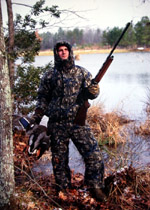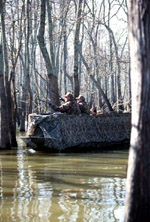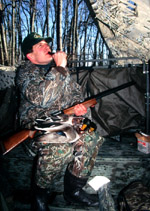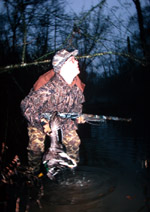
|
Features
|
|
|
|
Books
|
|
|
|
Fun & Games
|
|
|
|
Contact Us
|
|
|
John's Journal... Entry 119, Day 2
AMERICA'S BEST PUBLIC DUCK HUNTING
Migrating Patterns
 EDITOR'S
NOTE: My duck hunting partners, Tate Wood of Memphis, Tennessee, and
Buddy Harris of Greenwood, and I hunted in Mississippi from a flat-bottomed,
War Eagle boat with an Avery Quick Set Duck Blind that we could pop up
in less than a minute and drop to the side of the boat in about the same
time. I wasn't confident that we'd see many ducks in these public-land
hunting areas. And if I hadn't witnessed our hunts with my own two eyes,
I never would've believed that we would have the opportunity to take hundreds
-- even thousands -- of ducks each day.
EDITOR'S
NOTE: My duck hunting partners, Tate Wood of Memphis, Tennessee, and
Buddy Harris of Greenwood, and I hunted in Mississippi from a flat-bottomed,
War Eagle boat with an Avery Quick Set Duck Blind that we could pop up
in less than a minute and drop to the side of the boat in about the same
time. I wasn't confident that we'd see many ducks in these public-land
hunting areas. And if I hadn't witnessed our hunts with my own two eyes,
I never would've believed that we would have the opportunity to take hundreds
-- even thousands -- of ducks each day.
 Just
before the sun came up, I could hear the whistling sounds of the rapidly
beating wings of teal as they zoomed overhead and began to drop into our
decoys. "Will we shoot those ducks?" I asked. "We can if
you want," Tate Wood said. "However, we usually try to take
a limit of big greenhead mallards. On a bad day when we don't expect to
see many ducks, we probably will take the teal. But on a morning like
this when we've had a cold front arrive the day before we hunt, I expect
us to see plenty of flight ducks and a number of mallards. If we have
a chance to take the mallards, I believe we should let some of these other
ducks go."
Just
before the sun came up, I could hear the whistling sounds of the rapidly
beating wings of teal as they zoomed overhead and began to drop into our
decoys. "Will we shoot those ducks?" I asked. "We can if
you want," Tate Wood said. "However, we usually try to take
a limit of big greenhead mallards. On a bad day when we don't expect to
see many ducks, we probably will take the teal. But on a morning like
this when we've had a cold front arrive the day before we hunt, I expect
us to see plenty of flight ducks and a number of mallards. If we have
a chance to take the mallards, I believe we should let some of these other
ducks go."
 Wood
went on to explain that along the Mississippi Delta, ducks move up and
down the Mississippi Flyway, depending on weather patterns. For 10 days
before we arrived, a warm front had moved into the area. A large number
of the ducks holding in the Mathews Brake region apparently had flown
north then. But now with a severe cold front moving in from the north,
Wood promised that, "the ducks will be back." "I thought
when ducks came down the flyway they always migrated from north to south,"
I said. "Biologists tell us that tagging studies have indicated ducks
move up and down the flyway all during the winter migration," Harris
reported. "I know sometimes when duck-hunting pressure builds in
Louisiana and southwest Mississippi, some ducks will leave those areas
and fly north to our section of the flyway. When we get a warm spell,
the ducks will leave here and fly further north. Then when a cold front
arrives, those ducks will fly back into our region. That's what we're
betting on today." Harris barely had finished his comment before
Wood warned, "Get down. I see mallards coming."
Wood
went on to explain that along the Mississippi Delta, ducks move up and
down the Mississippi Flyway, depending on weather patterns. For 10 days
before we arrived, a warm front had moved into the area. A large number
of the ducks holding in the Mathews Brake region apparently had flown
north then. But now with a severe cold front moving in from the north,
Wood promised that, "the ducks will be back." "I thought
when ducks came down the flyway they always migrated from north to south,"
I said. "Biologists tell us that tagging studies have indicated ducks
move up and down the flyway all during the winter migration," Harris
reported. "I know sometimes when duck-hunting pressure builds in
Louisiana and southwest Mississippi, some ducks will leave those areas
and fly north to our section of the flyway. When we get a warm spell,
the ducks will leave here and fly further north. Then when a cold front
arrives, those ducks will fly back into our region. That's what we're
betting on today." Harris barely had finished his comment before
Wood warned, "Get down. I see mallards coming."
 In
the distance before us, I could see a flight of about 20 mallards approaching
our blind. Harris and Wood began to use their duck calls with the mastery
they had learned and practiced from their childhood. The ducks dropped
down almost immediately, gave our decoys a quick look and then flew past
us. Before the loud quacking greenheads had gone 50 yards past our blind,
Wood and Harris began to hit the birds again with hailing calls. Hearing
the hailing, the mallards appeared to hit a screen door, bounce off it
and turn back to check out our decoys a second time. "They're still
flying too high," Wood whispered to me. "Let's let them make
one more pass, and I believe we can bring them in with their feet out,
their wings cupped and their heads down. Then you can't miss."
In
the distance before us, I could see a flight of about 20 mallards approaching
our blind. Harris and Wood began to use their duck calls with the mastery
they had learned and practiced from their childhood. The ducks dropped
down almost immediately, gave our decoys a quick look and then flew past
us. Before the loud quacking greenheads had gone 50 yards past our blind,
Wood and Harris began to hit the birds again with hailing calls. Hearing
the hailing, the mallards appeared to hit a screen door, bounce off it
and turn back to check out our decoys a second time. "They're still
flying too high," Wood whispered to me. "Let's let them make
one more pass, and I believe we can bring them in with their feet out,
their wings cupped and their heads down. Then you can't miss."
TOMORROW: THE QUACKS COME IN
Check back each day this week for more about Duck Hunting...
Day 1 - America's Best Public
Duck Hunting
Day 2 - Migrating Patterns
Day 3 - The Quacks Come In
Day 4 - Another Great Duck-Hunting Spot
Day 5 - Secret Duck-Hunting Spots